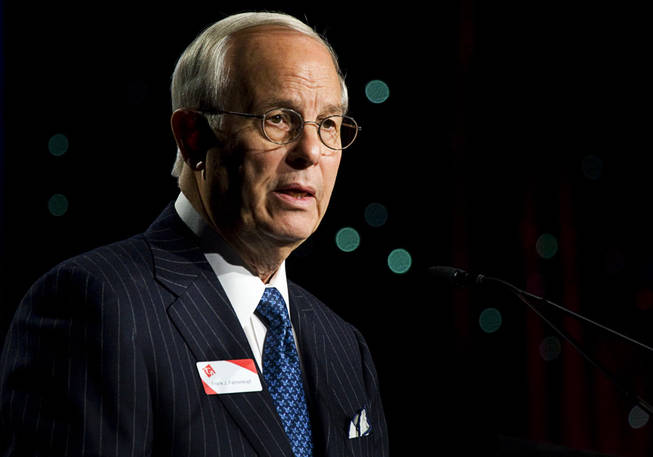The wave of consolidation that has swamped the gaming industry over the past couple of years has been compelling. Crane Payments acquired MEI. Scientific Games bought WMS. Bally acquired SHFL, and then was bought by Scientific Games. IGT acquired DoubleDown and then was scooped up by GTECH. And AGI/Novomatic seemed to be buying every company in Europe.
Not to mention AGS/Cadillac Jack, Amaya/PokerStars, Aristocrat/VGT, GCA/Multimedia Games… The list goes on and on.
But what does it really mean to the operator and the customers in the industry? Will this make it more costly to operate as fewer vendors compete for the business of the operators?
Frank Fahrenkopf should know. He ran the American Gaming Association for 17 years and saw companies come and go during his tenure. He says the current wave of consolidation came about because of the financial crisis that started in 2008.
“The gaming industry had been one of the world’s stellar growth industries over the past 20 years, growing in excess of 5 percent annually, until 2008 when the global financial crises hit,” Fahrenkopf says. “By 2014, some key gaming manufacturers were fully valued in terms of share price, and given the state of the industry, their boards of directors had to consider all options to fully realize that value for shareholders.
“My view is that this consolidation was a very natural outcome reflecting the state of the industry and financial market behavior. Market-led consolidation in this case will lead to short-term survival or strengthening, driving medium-term innovation and growth, and finally long-term exceptionalism. And it is this cycle that creates investment and employment to raise the economic standard of living around the world.”
Slimmer Slot Choices
With the IGT/GTECH, Scientific Games/WMS/Bally, Aristocrat/VGT, GCA/Multimedia Games and AGS/Cadillac Jack deals, operators now have fewer vendors from which to buy slot machines and systems. But Fahrenkopf says the trend is much deeper than that.
“In the case of GTECH/IGT and Scientific Games/Bally, we have lottery companies acquiring traditional gaming companies,” he says. “The merger and integration of their product lines creates an opportunity for end-to-end solution-selling, potentially transforming value for key customers. And yet, each company has products that individually lead industry categories, such as casino management systems and social gaming. Their challenge is delivering a successful operational and economic integration in a timely manner while still continuing to grow their businesses.”
And Fahrenkopf says he was impressed with the Aristocrat moves.
“What Aristocrat has achieved adding VGT’s Class II operations to their portfolio has been very smart and profitable, particularly in the way they have integrated the two businesses with such a careful, light touch,” he says. “Also, Aristocrat over the last four years has invested heavily in game development studios that now lead a number of operators’ purchasing surveys based on their very compelling content. Ultimately, placing Aristocrat games into VGT-dominant environments is a value-adding strategy of real merit.”
He doesn’t believe, however, that operator buying habits will change quickly.
“At least, in the medium term, I think much of the market will exhibit traditional buying behaviors allowing those companies who offer best-of-breed products (games, gaming machines, systems, etc.) to grow their market share in the gaps of a newly consolidated market,” says Fahrenkopf. “In Aristocrat, Konami and Ainsworth you have three companies that do not have to focus on integration or debt, but will focus on product innovation and service. Consolidation also creates space for innovation with new emerging companies developing compelling products.
“So in consolidation, the potential for doing it better is there with real competition. Real competition only demands that two companies compete because that is what drives innovation and value creation, and yet we have more than 400 gaming equipment manufacturers globally.”
For many years, IGT dominated the market with something approaching a 70 percent share. Fahrenkopf says that kind of thing is fleeting.
“Dominance in competitive markets is generally short-lived,” he says. “Market maturity, competition, innovation and value creation are all part of an important business cycle that drives industry. And the financial markets play an important part by ensuring the right balance of competitors exists the majority of the time.
“While we find ourselves in uncharted waters in the gaming industry today, I have full confidence that this is just another part of the gaming industry maturity cycle. I am rather excited by the potential of this consolidation to generate new value.”
Operator Options
With the recent spate of casino operators’ consolidation via real estate investment trusts, competition is once again getting tight in that arena. Fahrenkopf says REITs look good early on but could be problematic down the road.
“While it may have may have an immediate positive result by relieving leverage and increasing the stock price, the long-term impact cannot be predicted accurately,” he says. “For gaming operators to remain competitive, they must regularly commit large amounts of capital expenditure for the refreshment of premises, services and technology on the casino floors. As a REIT is required to distribute 90 percent of income to its shareholders, capital conflicts may develop as to what is in the relative best interests of each entity within the group. Only time will tell.”
For both operators and manufacturers, Fahrenkopf says that growth with the introduction of new jurisdictions is going to be problematic.
“The overall U.S. gaming market is flat at the moment, and therefore quite challenging for operators and manufacturers in the context of return on investment (ROI),” he says. “Both will be looking to drive ROI by shaving costs from operations through improving supply chain performance, restructuring entities and staff to achieve efficiencies, removing any service or product duplication for new economies, and reducing debt to unburden the balance sheet.
“Simultaneously, they will be looking to invest in additional services or products to existing customers through better understanding of their needs. New market segments are always a challenge, as they require significant capital, both human and financial. And I am sure they are thinking very much about the millennials and how to attract them to their venues.”
Testing Testimony
When Fahrenkopf stepped down as AGA president, he was approached by many companies to join their boards or become an adviser. He rejected most of the invitations, but was fascinated by a bid from BMM Testlabs, which was trying to break into a U.S. testing market dominated by one supplier.
“We should never entertain the notion that a monopoly, be it actual or effective, is beneficial to any industry, its stakeholders or the public,” he says. “Competition and free markets go together, and as an American, I cannot believe in anything more powerful.”
He says the U.S. market is really the only global market so dominated.
“In the independent gaming lab (ITL) markets around the world, no actual or effective monopolies exist except in the U.S., where a handful of regulators have unwittingly enabled an effective monopoly by not licensing other qualified ITLs. I came to BMM as a director to resolve this issue, not only for BMM but also for all qualified ITLs and for the best interests of the entire gaming industry.”
Since BMM has been licensed in multiple U.S. jurisdictions, Fahrenkopf says the time used for testing games has been reduced from 90 days to an average of around 20. He says quality denials have been reduced by 10 percent or more, and, most importantly, costs to the manufacturers and regulators have been gradually reduced by 20 percent.
Martin Storm, the chairman and CEO of BMM Testlabs, says the days of states launching and operating their own test labs are numbered.
“Historically, there has never been significant momentum for state regulators to set up their own laboratory,” Storm says. “Jurisdictions such as Nevada and New Jersey created their own labs out of necessity since private gaming test labs did not exist in the U.S. at the time. Other jurisdictions such as Mississippi and Michigan followed a Nevada model wherein Pennsylvania followed a New Jersey model.
“The vast majority of jurisdictions have elected to utilize private labs, as running a laboratory is expensive, requires constant ongoing education and must be able to be flexible in order to deal with the variable workload that can occur.”
Regulators who use private labs, says Storm, can focus on innovation and new technologies while allowing highly accredited and experienced private laboratories to handle the day-to-day testing of the technology.
“As one of only two global ITLs, BMM has international market reach, expertise, experience, performance and technology access that cannot be matched by an individual government gaming lab, no matter how big they are,” he says.
Regulator Education
The rapid turnover of regulators in all jurisdictions makes it essential that ITLs help to educate them on new technology, trends in the marketplace, and legal issues that will come before them before long. Fahrenkopf says education is essential to keep the industry running smoothly.
“The world of gaming regulators has transformed over the years with the advent of new market segments within existing jurisdictions like the VGA venues in Illinois, and new technology platforms to implement such as casino management systems, VLT monitoring systems, mobile technology, sports betting technology, and iGaming systems and more,” he says. “Very few regulators around the world have the budgets available to keep up with these changes. Most regulators are challenged by limited resources, and at a time when these changes are only accelerating.
“So, providing effective education for regulators, who often turn over rapidly, must be a primary priority of the industry. When I was with the AGA, our educational programs for regulators at our G2E shows and in conjunction with IAGA went a long way toward development of a standard for such education. Understanding the industry and how it functions must be a benchmark for every regulator who seeks to do an outstanding job.”
Storm says governments need to understand that regulators must be constantly updated on developing trends in the industry.
“The first step is for government to provide more funding for the management, hiring and development of staff in this evolving and complex technology environment,” he says. “The pace of change is accelerating, and regulators are challenged to keep abreast. Without appropriate financial support, the costs to the jurisdiction are lost opportunities and a real risk to their public.
“The next step is that regulators can broaden their support base beyond marketing from powerful industry players to include other industry participants. Asking for support from others who are willing to help is an effective strategy for improving knowledge and skills, and broadening the message base. At BMM, we often engage with regulators who are struggling to understand technology and the regulatory implications. They should ask us, as well as others.”
Good to Go
Storm says U.S. regulators are beginning to realize that using ITLs makes sense for their jurisdictions. While the RFP process can be cumbersome, he believes that is appropriate for goods and services that the state governments buy. But with ITL testing services, he says, the individual manufacturers pay for that service, not the states (except where the state hires the ITL as a consultant).
So, the states should not be limiting those manufacturers to doing business with one ITL; they should open it up to all qualified ITLs, even if only one ITL is serving as the state consultant, says Storm. Therefore, an “RFQ”—request for qualifications—is more appropriate when considering the ITLs the state will approve for testing. The qualification of established ITLs is a crucial step to efficient regulation, effective oversight and quality service for a fair price, he says.
“ITLs are qualified and accredited organizations that professionally test products for certification,” Storm says. “Like other professionals firms, e.g. attorneys, accounting, audit, consulting and IT, it is their expertise and performance in the commercial and tribal markets that determines their fate. The state (country or tribe) is also a beneficiary of that expertise. Working with, and representing the gaming regulator effectively, is part of the overall service for a professional gaming ITL, everywhere.
“With the exception of a few U.S. gaming jurisdictions, BMM has been chosen by every major and minor gaming jurisdiction in the world for its experience and excellence in gaming product certifications and software testing. This is BMM’s core competence, and where its results speak for themselves, particularly in the U.S. market.”
Fahrenkopf believes that the competition is good for the industry in all disciplines, and having multiple qualified test labs can only work to everyone’s benefit.
“The public deserves the very best choices in entertainment, gaming, hotels, restaurants, bars and more,” he says. “It is the link between operators, manufacturers, suppliers and test labs in a truly competitive environment that underpins the ‘best’ to be available to them, and protects them. No other model will do.”
Originally published by GGB Magazine






